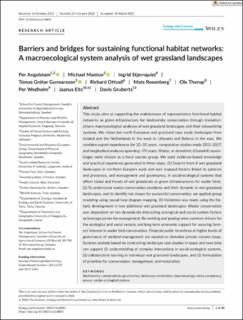| dc.contributor.author | Angelstam, Per Krister | |
| dc.contributor.author | Manton, Michael | |
| dc.contributor.author | Stjernquist, Ingrid | |
| dc.contributor.author | Gunnarsson, Tómas Grétar | |
| dc.contributor.author | Ottvall, Richard | |
| dc.contributor.author | Rosenberg, Mats | |
| dc.contributor.author | Thorup, Ole | |
| dc.contributor.author | Wedholm, Per | |
| dc.contributor.author | Elts, Jaanus | |
| dc.contributor.author | Gruberts, Davis | |
| dc.date.accessioned | 2022-08-31T08:47:32Z | |
| dc.date.available | 2022-08-31T08:47:32Z | |
| dc.date.created | 2022-05-31T15:17:06Z | |
| dc.date.issued | 2022 | |
| dc.identifier.citation | Ecology and Evolution. 2022, 12 (4), 1-20. | en_US |
| dc.identifier.issn | 2045-7758 | |
| dc.identifier.uri | https://hdl.handle.net/11250/3014637 | |
| dc.description.abstract | This study aims at supporting the maintenance of representative functional habitat networks as green infrastructure for biodiversity conservation through transdisciplinary macroecological analyses of wet grassland landscapes and their stewardship systems. We chose ten north European wet grassland case study landscapes from Iceland and the Netherlands in the west to Lithuania and Belarus in the east. We combine expert experiences for 20–30 years, comparative studies made 2011–2017, and longitudinal analyses spanning >70 years. Wader, or shorebird, (Charadrii) assemblages were chosen as a focal species group. We used evidence-based knowledge and practical experience generated in three steps. (1) Experts from 8 wet grassland landscapes in northern Europe's west and east mapped factors linked to patterns and processes, and management and governance, in social-ecological systems that affect states and trends of wet grasslands as green infrastructures for wader birds. (2) To understand wader conservation problems and their dynamic in wet grassland landscapes, and to identify key issues for successful conservation, we applied group modeling using causal loop diagram mapping. (3) Validation was made using the historic development in two additional wet grassland landscapes. Wader conservation was dependent on ten dynamically interacting ecological and social system factors as leverage points for management. Re-wetting and grazing were common drivers for the ecological and social system, and long-term economic support for securing farmers’ interest in wader bird conservation. Financial public incentives at higher levels of governance of wetland management are needed to stimulate private income loops. Systems analysis based on contrasting landscape case studies in space and over time can support (1) understanding of complex interactions in social-ecological systems, (2) collaborative learning in individual wet grassland landscapes, and (3) formulation of priorities for conservation, management, and restoration. | en_US |
| dc.language.iso | eng | en_US |
| dc.rights | Navngivelse 4.0 Internasjonal | * |
| dc.rights.uri | http://creativecommons.org/licenses/by/4.0/deed.no | * |
| dc.subject | biodiversity | en_US |
| dc.subject | conservation | en_US |
| dc.subject | governance | en_US |
| dc.subject | landscape restoration | en_US |
| dc.subject | macroecology | en_US |
| dc.subject | meta-conspiracy | en_US |
| dc.subject | power | en_US |
| dc.subject | social–ecological system | en_US |
| dc.title | Barriers and bridges for sustaining functional habitat networks: A macroecological system analysis of wet grassland landscapes | en_US |
| dc.title.alternative | Barriers and bridges for sustaining functional habitat networks: A macroecological system analysis of wet grassland landscapes | en_US |
| dc.type | Peer reviewed | en_US |
| dc.type | Journal article | en_US |
| dc.description.version | publishedVersion | en_US |
| dc.subject.nsi | VDP::Matematikk og Naturvitenskap: 400 | en_US |
| dc.source.pagenumber | 1-20 | en_US |
| dc.source.volume | 12 | en_US |
| dc.source.journal | Ecology and Evolution | en_US |
| dc.source.issue | 4 | en_US |
| dc.identifier.doi | 10.1002/ece3.8801 | |
| dc.identifier.cristin | 2028506 | |
| cristin.ispublished | true | |
| cristin.fulltext | original | |
| cristin.qualitycode | 1 | |

